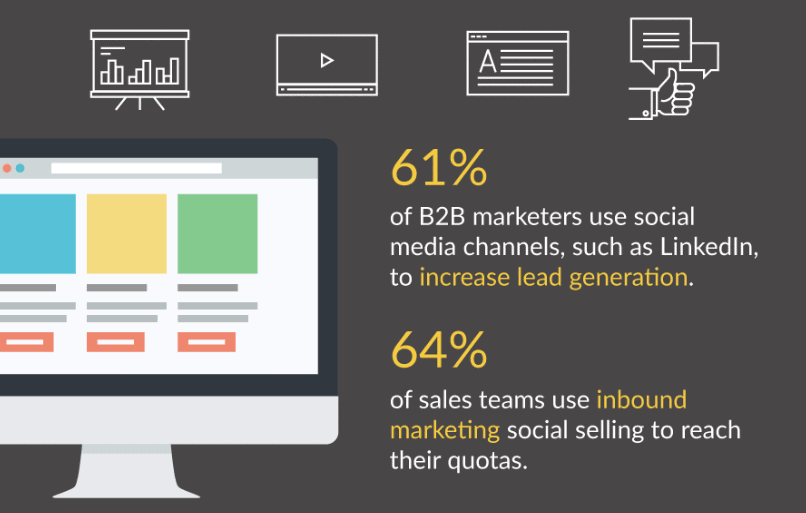Tired of having to scrounge for leads?
Do you need a new way to find more and better leads to skyrocket your business?
Then this blog about building an inbound lead flow machine with social content is for you.
Using social media and content to generate quality leads and turn potential customers into paying customers is critical to a successful business strategy.
This article will explore the best platforms, optimization strategies, ad options, incentives, personalization tactics, analytics tools, and more to create an efficient inbound lead flow machine that produces quality leads.

Understanding the Basics of Lead Generation
Businesses can create an effective inbound lead flow machine by understanding the basics of lead generation, crafting engaging social content through visual media, leveraging influencers, and creating a content strategy that optimizes posts for maximum effectiveness.
The effectiveness of such campaigns can then be measured using analytics tools to refine the process further.
Utilizing tactics such as content optimization, website metrics, and website forms can help to create an effective lead generation process.
Targeting demographics, segmenting audiences, and leveraging data are all essential components of inbound lead generation on social media.
Optimizing campaigns by creating content unique to specific locations or services can help attract the right kind of leads. Optimizing titles, images, and page layouts will ensure visitors have an enjoyable experience when landing on a web page.
Websites should also be designed to include white space around forms, making it easier for visitors to understand the text and take action. Moreover, sign-up forms should have a hard-to-resist call to action with a visible way to exit to encourage potential customers to provide contact information.
Nurturing leads is also crucial; providing value through case studies or ebooks will demonstrate a business’s ability to solve customer pain points. Free courses offer expertise and build confidence in their solutions.

Crafting Engaging Social Content
Engaging social content is essential for generating inbound leads and nurturing their interest to turn them into paying customers. To increase lead generation, businesses need to focus on interactive posts, influencer relations, content personalization, audience segmentation, and calls to action:
- Interactive posts create an engaging environment that drives further interaction with the brand. This can include polls and quizzes that encourage users to engage with the brand on a deeper level.
- Establishing relationships with influencers can help build trust in the brand and drive more leads from their followers. By leveraging influencers’ reach, brands can tap into new audiences quickly and efficiently.
- Content personalization allows businesses to target specific audience segments by tailoring content to match individual needs or interests. This helps ensure that users receive relevant messages that resonate with them and encourage them to act.
- Audience segmentation enables businesses to understand their target audience better so they can tailor their campaigns accordingly and deliver more effective results.
- Calls-to-action should be clear, concise and direct so visitors know how to proceed after reading or interacting with a post or landing page element such as a form or button.
By implementing these strategies within social media campaigns, brands can increase lead generation efforts while delivering more relevant messages simultaneously and ultimately improving customer engagement.
Utilizing Visual Media
Visual media can be leveraged to create an immersive experience for potential customers, thus driving engagement and improving lead generation. Through visual storytelling – using engaging images, videos, and audio – businesses can effectively communicate their message in a visually appealing way.
- Image selection is a critical element of visual storytelling; selecting the right image that matches the message is crucial for success.
- Videos have become one of the most powerful tools for lead generation on social media as they are more engaging and memorable than text or static images alone.
- Social media trends such as Stories and Reels also allow businesses to create creative content that resonates with audiences.
- Visual media is essential for effective inbound lead flow machine creation through social content.
Content optimization should be considered when creating visual media; optimizing visuals for mobile devices, ensuring fast loading times, and compressing file sizes are all important considerations when crafting visuals for social platforms.

Leveraging Influencers
Influencer marketing has become an increasingly popular method for businesses to reach potential customers and expand their reach, as demonstrated by the increasing number of influencers brands rely on to promote their products. Leveraging influencers is a great way to build relationships with potential customers, increase brand awareness, and create engaging content.
Businesses can use the following strategies to tap into the power of influencers for inbound lead generation:
- Influencer Outreach – Reach out to influencers with an audience relevant to your business’s target market.
- Relationship Building – Build authentic relationships with influencers who align with your company’s values and goals.
- Content Outreach – Develop compelling content that resonates with your target audience and share it across multiple channels.
- Promotion Strategies – Utilize various promotional strategies such as giveaways, contests, or sponsored posts to attract leads.
Additionally, tracking metrics such as impressions, engagement rate, and conversions are essential for analyzing the success of these campaigns and optimizing them accordingly.
Utilizing Chatbots for Lead Generation
As you probably have noticed, chatbots are becoming increasingly widespread on many companies websites. They offer a direct line of communication with your audience and can operate 24/7, providing instant responses and answering frequently asked questions.
Chatbots can be integrated into social media platforms like Facebook and Instagram, and they can initiate conversations, qualify leads, and even direct users to relevant content or products based on their responses.
But chatbots can also be used to collect contact information from leads in a conversational manner, which can be less intrusive than traditional web forms.
How?
By creating a script that offers value in exchange for contact information, you can effectively gather leads with a chatbot. For instance, a chatbot might ask visitors if they would like to receive an ebook or a discount code in exchange for their email address.
Additionally, chatbots provide valuable data and insights about your leads, such as their interests, behaviors, and preferences. This information can be used to improve your content strategy, personalize your communications, and deliver a better customer experience.
The Power of User-Generated Content
User-generated content (UGC) is any form of content, such as images, videos, text, and audio, that has been posted by users on online platforms. It can be a powerful tool for lead generation as it promotes authenticity, increases engagement, and can influence purchasing decisions.
User-generated content is everywhere these days, and if your business isn’t using it, It’s time.
UGC can be encouraged through social media contests, hashtag campaigns, or even by simply asking your audience to share their experiences with your product or service.
For instance, you could ask your customers to post a photo of themselves using your product, along with a specific hashtag. You could then feature these posts on your own social media channels or website, providing visibility for your customers and authentic promotional content for your brand. Plus, now you have a lead on someone who is interested in your product.
UGC not only increases engagement but also promotes trust as potential customers tend to trust other users more than brands. As a result, UGC can be a great way to attract and convert leads.

The Role of Social Listening in Lead Generation
Social listening involves monitoring social media platforms for mentions of your brand, competitors, products, and more. It’s a great way to understand the conversations happening around your industry and to identify potential leads.
By tracking specific keywords or phrases, you can discover users who may be interested in your products or services. For example, if you are a fitness equipment manufacturer, you could monitor phrases such as “home gym equipment” or “best fitness gear”. People using these phrases may be potential leads.
Social listening can also help you identify influencers or industry leaders with whom you might want to collaborate. This could give you access to a wider audience and more potential leads. Bulk.ly offers social listening tools that can help you find more potential customers in no time, everytime your brand is mentioned.
Finally, social listening allows you to understand your audience’s pain points, preferences, and questions, which can inform your content strategy and help you create more targeted, engaging content to attract and convert leads.
Creating a Content Strategy
Developing a content strategy is essential to effectively engage potential customers and generate meaningful leads.
When creating a content plan, businesses should consider their audience targeting and the type of call-to-action they want to use to convert leads into customers. Keyword research helps inform the content topics that will be most successful in generating leads while post-scheduling ensures posts are uploaded on the right platforms at the correct times.
Content optimization involves writing, formatting, and updating content to make it accessible and valuable to the target audience; this includes adjusting titles, images, and page layouts for improved lead generation. Additionally, website metrics such as bounce rate, average time on page, and traffic sources can help identify areas of opportunity for enhanced lead generation.
By creating a comprehensive content strategy with effective tactics for reaching their target audience and optimizing each piece of content for engagement, potential leads can be converted into paying customers.

Optimizing Your Posts
A content strategy for generating social media leads is essential for inbound lead flow. However, to effectively convert leads to customers, organizations must also focus on optimizing their posts.
Optimizing posts involves engaging customers through visuals, targeting the right audiences, incentivizing leads with offers and discounts, and understanding current trends.
When creating content for social media platforms, organizations should ensure it is visually appealing by incorporating high-quality images or videos. Additionally, it is vital to understand which types of content resonate with different target audiences by analyzing data and trends from analytics tools.
Organizations can use these insights to tailor their posts and create personalized experiences that meet customer needs. Furthermore, companies should leverage incentives such as contests and discounts to increase engagement and attract leads.
Organizations can build an effective inbound lead flow machine using engaging content by understanding how to optimize social media posts.
Measuring Your Results
To ensure the success of social media lead-generation efforts, organizations must measure their results and refine their strategies accordingly.
A/B testing, website metrics, website forms, content optimization, and cookies are all essential tools that can help to assess the efficacy of an organization’s social media lead generation strategy. A/B testing allows organizations to compare two versions of a page to determine which works best for maximum conversion rate.
- Website metrics such as bounce rate, average time on page, and traffic sources can help identify areas of opportunity for improved lead generation.
- Additionally, website forms should be placed above the fold with relevant keywords and a statement like ‘Unsubscribe at any time’ for further engagement with potential leads.
- Content optimization involves writing engaging copy tailored to each stage of the buyer’s journey while considering variables such as titles and images for effective lead generation.
- Finally, non-necessary cookies should only be used if user consent is obtained beforehand to protect personal data.

Refining Your Process
Having established the factors determining a successful inbound lead flow machine, it is now time to refine the process. Refining the process involves incentivizing leads, personalizing messages, tracking analytics, leveraging forms and optimizing cookies.
- Incentivizing leads can be done through contests, discount codes and gated content that give users valuable information.
- Personalizing messages via targeting and retargeting ads and Dynamic Ads on LinkedIn with direct calls-to-action can significantly impact lead generation.
- Tracking analytics helps measure and refine lead generation efforts by setting up goals in Google Analytics to track leads or using social analytics tools to understand creative and messaging performance.
- Website forms are essential for collecting user information and should be placed above the fold with relevant keywords alongside an unsubscribe statement.
- Finally, optimizing cookies provides users with a more tailored experience while keeping their data safe; necessary cookies ensure basic functionalities, while non-necessary ones require user consent before collecting any data.
By following these steps, businesses can create an effective inbound lead flow machine that drives results.
Final Thoughts on Inbound Lead Flow
Lead generation is a critical component in any business’s success.
Businesses can create an effective inbound lead flow machine that will drive quality leads by creating engaging social content, leveraging influencers, and using visual media to optimize posts.
The irony lies in the fact that while it may seem daunting at first, simple strategies can yield excellent results with minimal effort.
With the right approach and analytics to measure progress, businesses can see positive returns on their investments and maximize their potential for success.


